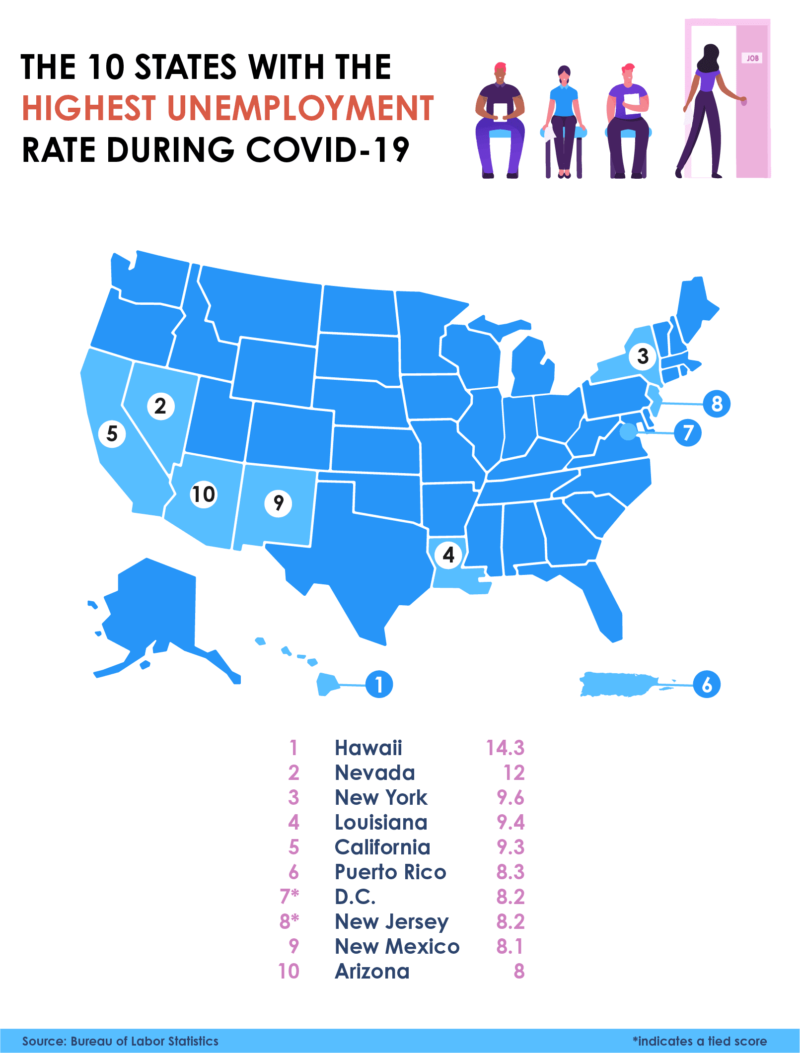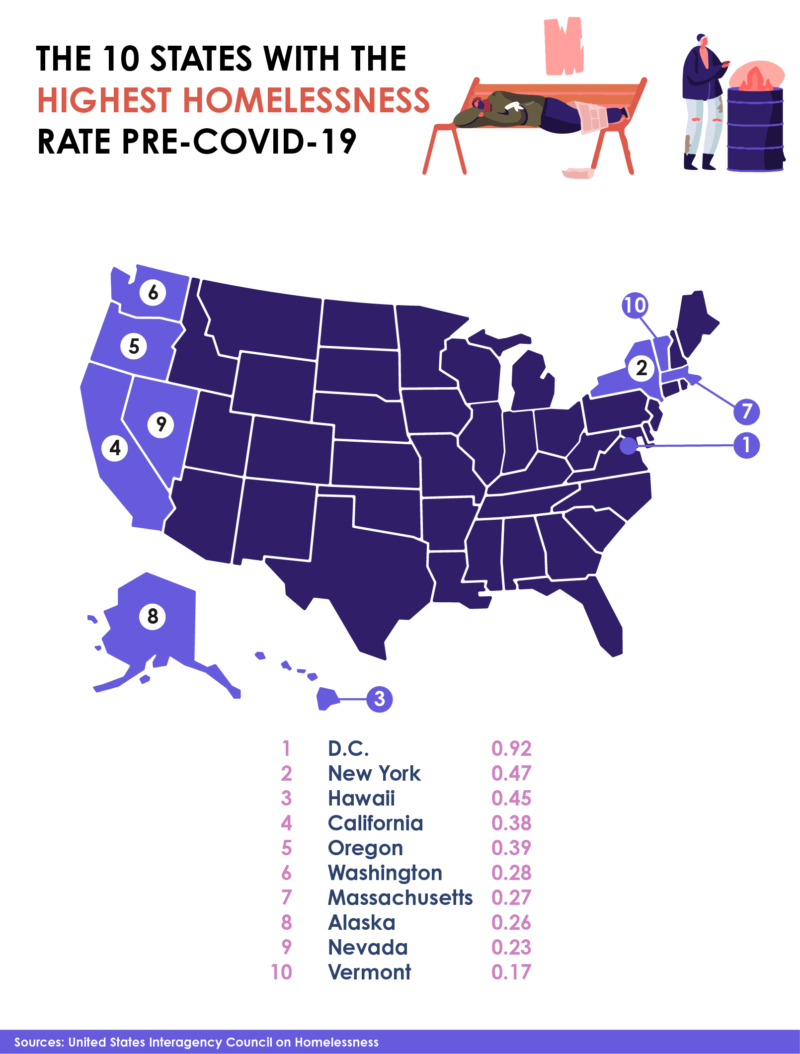The Impact of the COVID-19 Pandemic on Homelessness in the United States
Jan 12, 2021

The COVID-19 pandemic has produced a unique set of public health challenges. But the pandemic has exacerbated national crises that existed long before the coronavirus. Nowhere is this more evident than in the pandemic’s influence on homelessness and affordable housing.
COVID-19 has posed, and continues to pose, unique risks for people experiencing homelessness. Social services have become more limited throughout 2020. But the economic consequences of the pandemic have put more Americans at risk of entering homelessness.
These challenges are faced by individuals across the country, including many in the nation’s capital. At United Way of the National Capital Area, we work closely with regional social services providers through our support of 2-1-1 social service hotlines. The 2-1-1 Warmline is the District of Columbia’s centralized hub for social service resources and referrals. Please refer to the DC 2-1-1 Warmline for 211-related services: https://211warmline.dc.gov/.
The realities of facing homelessness and the pandemic are different for every person and family. Still, the national statistics around these dual crises provide important insight into this issue. We were interested in what the data would reveal. In light of this, we decided to conduct an analysis of the data available on homelessness around the country during COVID-19. We paid special attention to the following factors:
- -Eviction filings
- -Local rent forgiveness policies
- -Health care access for people experiencing homelessness
The results below reflect COVID-19’s impact on people experiencing homelessness during these extraordinarily difficult times.
The Cities Experiencing the Most Evictions Due to COVID-19

In the initial stages of our analysis, we looked at the states with the most eviction filings during COVID-19. Notably, there was not one specific region in the country that was a center for COVID-19-related evictions. The top cities where this occurs included Phoenix, Houston, and Memphis, spanning across the country and across different regional industrial centers.
The large volume of evictions left many people experiencing homelessness unhoused as shelters were forced to reduce capacity. Interestingly, this surging number of evictions led to a federal order to temporarily halt residential evictions to prevent the spread of COVID-19. However, for many landlords, the order created a financial burden of housing renters with no payments.
The US Department of Housing and Urban Development noted in their 2019 annual report that in America’s 50 most populous cities, African-Americans make up the majority of the homeless population. Of the top 10 cities with the most eviction filings, numbers one through eight all qualify for that top 50 designation, meaning that the added stress these evictions are placing on resources dedicated to assisting those experiencing homelessness may be producing outsize negative impacts on homeless populations that are primarily composed of minorities.
Looking into what caused these evictions, many would expect the largest indicator of eviction to be job loss. Therefore, we looked at the states with the highest unemployment rates during COVID-19.
The States with the Highest Unemployment Rate Due to COVID-19

Again, there was no clear region in the country where COVID-19 led to the greatest leap in unemployment. However, it is clear from the data that statewide unemployment has been closely tied to local industries and their pandemic-related losses.
For instance, the top two states for unemployment as of October 2020 were Hawaii and Nevada, both of which depend on tourism to fuel their local economies. For these states, people face unique challenges in moving out of homelessness as a lack of income severely limits their housing options, as cited by the National Coalition for the Homeless.
The States with the Highest Homelessness Rate Pre-COVID-19

Having looked at these causative factors, we moved on to the data surrounding the prevalence of homelessness itself. We wanted to look at pre-COVID-19 data to get an indication as to where homelessness was especially common before the pandemic, as the coronavirus is likely to be especially challenging for states with pre-existing affordable housing crises.
According to data from the United States Interagency Council on Homelessness, in 2019, the states with the highest rates of homelessness were Washington, DC, New York, and Hawaii. While some of the percentages may seem low, it is worth noting that for states with larger populations like New York, even less than 1% of people experiencing homelessness translates to tens of thousands of people who might turn to social services for support and temporary housing. For that reason, we also looked at the cities with the most homeless shelters.
The 10 Cities with the Most Homeless Shelters

Many states are unable to provide extensive support to these massive groups, which leads to greater rates of chronic homelessness across the state, a crisis that even preceded COVID-19.
The states with the most existing homeless shelters also had the most robust system in place to provide temporary shelter to those experiencing homelessness. Top areas in the United States included Washington, DC, Los Angeles, and Baltimore. Unfortunately, as public health guidelines have restricted person-to-person contact, many homeless shelters across the country have been forced to close, as reported by the National Low Income Housing Coalition.
With all of these statistics offering insights on which states may be especially vulnerable to experience homelessness as a result of COVID-19, we also wanted to look at the health effects of severe housing costs.
The 10 States with the Most Severe Housing Cost Burden Pre-COVID-19

For many people, being at risk of homelessness means that huge proportions of household budgets are dedicated to renting and mortgage payments. That money comes away from doctor’s visits, healthy foods and basic needs that may harm individuals’ health, according to County Health Rankings from the Robert Wood Johnson Foundation.
The states with the highest severe housing cost burden, or the percentage of households that spend 50% or more of their household income on housing payments, included California, New York, and Hawaii. For individuals in these situations, increased pressure on health and hunger services may have put even more pressure on their already-strapped budgets, perhaps even forcing some people into homelessness during this pandemic.
Finally, we wanted to look at how the pandemic has impacted the health of people experiencing homelessness. For everyone, expensive health care associated with the pandemic has been a major concern. Everything from rapid test costs to emergency room bills has been on the minds of individuals worried about their budgets and their health.
The Impact of COVID-19 on Health Care for the Homeless

We looked at the status of health centers dedicated to helping people experiencing homelessness and other at-risk populations. These health centers receive funding known as 330(h) funding. Throughout the pandemic, each month health centers with 330(h) funding have closed due to increased costs and social distancing requirements. However, the average number of health centers closed each month has fallen by about 400 health centers. This availability of health care may have helped reduce the spread of COVID-19 in homeless populations, which has fallen to a prevalence of 9% on average.
Still, that prevalence is especially high. According to the data from COVID-19 tests in 330(h) health centers, rates of COVID-19 among populations of people experiencing homelessness and other underserved populations are high. According to Johns Hopkins University’s Coronavirus Resource Center, the highest single 7-day rate of positive COVID tests for the entire United States population between the months of June and October was 7.8% (with the rate falling as low as 4.0% in that time). The National Health Care for the Homeless Council reported that COVID positivity rates for those experiencing homelessness feel in an average range of 9-12% for that same time period. Augmenting the general dangers presented by increased positivity rates among a given population, the CDC reports that since many people experiencing homelessness are often older adults or have underlying medical conditions, they may face even more severe illness due to COVID-19.
The sum total of the data we collected and analyzed for this piece paints a dispiriting picture for those experiencing homelessness as well as the services and people dedicated to helping them. The COVID-19 pandemic has only served to exacerbate existing issues for those who are homeless, while also adding scores to their ranks. Job and income loss throughout the country have seen people from coast to coast get evicted from their homes, creating a major increase in the number of people seeking out resources and support systems designed to help the homeless. This is happening at the same time that the virus and restrictions designed to curb its spread have forced homeless shelters across the nation to shutter their doors, in some cases permanently. Not even cities with strong support systems in place have been immune to these realities.
Beyond all of those concerns, there is still the reality of the virus itself, and the impacts it has had and will continue to have on the health of individuals experiencing homelessness in this country. Given the advanced ages and underlying health issues many people experiencing homelessness have to deal with in the best of times, the increased infection rates and lack of healthcare resources represents a significant threat to America’s homeless population.
With this data reflecting that homelessness during COVID-19 is widespread and far-reaching in its impacts, it is so important that the public health of this population is carefully considered. As we move beyond the pandemic, and lingering effects of homelessness shape the lives of so many people, awareness of how public health, household budgets and social services interact will be essential. If you live in the National Capital Area and want to learn more about accessing or supporting these essential programs, read more about the services and programs offered by our organization.
Sources
Cities with the Most Eviction Filings During COVID-19
States with the Highest Unemployment Rate During COVID-19
States with the Highest Pre-COVID Homeless Rate
States with the Most Severe Pre-COVID Housing Cost Burden
- -Source: https://www.countyhealthrankings.org
Positive COVID Test Rate for Homeless Population
- -Source: https://nhchc.org/covid-dashboard/
States with the Most Homeless Shelters
- -Source: https://www.shelterlistings.org/



